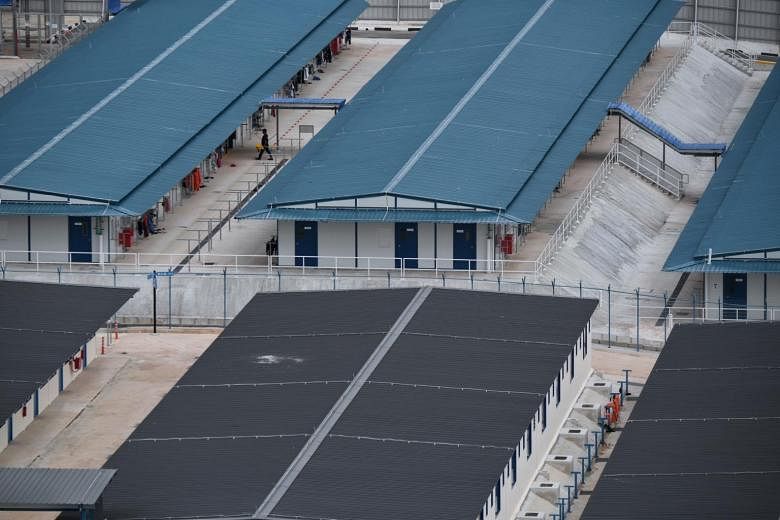SINGAPORE - Migrant workers living in newly built dormitories here can expect improved living spaces, including having en-suite toilets shared among fewer people and a cap of 12 residents in each room.
The improved standards come after a year-long review and pilot scheme in semi-permanent Quick Build Dormitories (QBDs) that were built to reduce density in existing dorms last year.
The finalised set of new standards will apply to all new dormitories, including purpose-built dormitories (PBDs), factory-converted dormitories, construction temporary quarters and temporary occupation licence quarters.
In a joint statement on Friday (Sept 17), the Ministry of Manpower (MOM), Ministry of National Development (MND) and Ministry of Health (MOH) said they had refined the standards based on feedback, the experience with the QBDs, and managing the Covid-19 outbreak in the dormitories.
The living conditions of migrant workers in dormitories came under close scrutiny after the massive outbreak of Covid-19 infections last year.
Ms Chew Ee Tien, director of MOM's foreign manpower unit, said the new standards will reduce the risk of similar outbreaks in dorms and make them more liveable.
The idea is to "modularise" new dorm spaces, allow new cases to be detected early and isolated, as well as to improve ventilation, she added, noting that workers will still have to follow safe workplace and living measures.
Manpower Minister Tan See Leng told reporters the new dorm standards are part of a multi-pronged approach to ensure migrant workers have access to a resilient living, working, social and healthcare environment.
While the improved standards may lead to higher costs, he said: "Prevention is always better than cure, especially as we have seen the potentially grave implications of a disease outbreak on migrant workers, employers, and Singapore's economy."
This latest set of standards, however, does not go as far as the ones that were mooted previously.
Last June, the authorities had proposed a maximum of 10 beds to a dorm room, with only single-deck beds spaced at least 1m apart allowed. However, the finalised set of standards will allow double-decker beds and raises the occupancy cap slightly to 12.
Similarly, while en-suite toilet facilities will be mandatory for every room, they will be shared among six residents, instead of five as previously suggested.
Still, this is an improvement from current standards, where 12 to 16 workers share a dorm room, with no limits on room capacity.
In most dorms now, about 15 residents share a set of toilet facilities, which can be en suite or shared among different rooms.
Dorms currently have to provide a minimum 3.5 sq m of living space, excluding shared facilities such as en-suite kitchens, toilets and yard spaces.
With the latest set of standards, this requirement goes up to a minimum of 4.2 sq m of living space for new dorms.
Last June, the authorities proposed a minimum of 6 sq m of living space.
Asked about these differences, MOM deputy secretary for workforce, Mr Poon Hong Yuen, said developing the new standards is not a "simple mathematical calculation".
The safe management measures put in place, along with contact tracing measures, gave the authorities space to relax some of the proposed standards, he added.
Ms Chew said the decision to mandate at least 4.2 sq m of living space in new dorms instead of 6 sq m took in account the fact that disease transmission could still occur within dorm rooms.
Hence, the authorities focused on other issues key to reducing transmission, such as room occupancy limits, en-suite toilets and ventilation, she said.
Allowing double-decker beds also means having more open areas in the dorms and less clutter in rooms, she added.
New dorms must also meet additional criteria, such as ventilation requirements and the segmentation of communal facilities.
At least one exhaust fan has to be installed per toilet, along with an adequate number of fans in dorm rooms to ensure sufficient air circulation.
If air-conditioning is provided in the room, operators for new dorms must also install medical-grade air filters.
The occupancy limit per dorm floor remains at 240 residents, but new dorms must be able to be divided into self-contained sections of 120 residents.
Communal facilities in new dorms - such as cooking, dining and laundry areas - must also be designed for dedicated use by up to 120 residents per section.
All new dorm rooms must also provide free Wi-Fi, which is currently offered only in common areas.
Other requirements include outdoor recreation areas in all new dorms. Currently, only dorms with more than 1,000 residents need to have such spaces.
These larger dorms will now also be required to have at least one grass field that is at least 100 sq m, and at least 0.15 sq m of open grass field per resident.
New dorms must also have sheltered laundry areas, and separate sanitation lines for each block to allow for wastewater surveillance testing.
Finally, newly built dorms must have at least 10 isolation beds for every 1,000 bed spaces, up from just one per 1,000 bed spaces now.
They must also be able to add another 15 more isolation beds per 1,000 bed spaces during pandemics, compared with the 19 additional isolation beds per 1,000 bed spaces required now.
The new standards will be applied first to two new PBDs that will be launched next year. Located in Kranji and Jalan Tukang, they are expected to be completed in three years and will have at least 12,500 beds.
The Government will construct and own these dormitories, while the day-to-day operations will be managed by a dormitory operator.
This is a new operating model from the current one, where land is released for commercial dorms operators to bid, build or operate PBDs.
The Government will review the ownership and operating model for subsequent new PBDs, depending on the demand for beds and market conditions at that time.
In June last year, the authorities laid out plans to build new PBDs that can house up to 100,000 workers.
MOM and MND said then that 11 such PBDs would be ready by 2022. The two new PBDs in Kranji and Jalan Tukang are part of these 11 dorms.
Asked about the remaining nine PBDs that were promised, Mr Cham Dao Song, senior director for strategic planning at MND, said two will suffice for now, based on latest estimates of worker numbers and the current demand and supply of beds.
MOM's Mr Poon also noted that some of the dorms now have a higher vacancy rate than before the pandemic.
In April, the average occupancy in PBDs was around 60 per cent of the maximum occupancy limit, compared with 88 per cent a year ago.
Existing dorms will transition to the new standards in a phased manner, said Mr Poon. More details are expected early next year.



